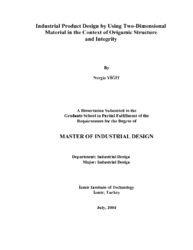Please use this identifier to cite or link to this item:
https://hdl.handle.net/11147/3353| Title: | Industrial Product Design by Using Two-Dimensional Material in the Context of Origamic Structure and Integrity | Authors: | Yiğit, Nergiz | Advisors: | Seçkin, Yavuz | Publisher: | Izmir Institute of Technology Izmir Institute of Technology |
Abstract: | Throughout the history of industrial product design, there have always been attempts to shape everyday objects from a single piece of semi-finished industrial materials such as plywood, sheet metal, plastic sheet and paper-based sheet. One of the ways to form these two-dimensional materials into three-dimensional products is bending following cutting. Similar concepts of this spatial transformation are encountered in the origami form, which has a planar surface in unfolded state, then transforms to a three-dimensional state by folding or by folding following cutting. If so, conceptually it may be useful to think of one-axis bending, which is a manufacturing technique, is somewhat similar to folding paper.In this regard, the studies in the scope of computational origami, which light the way for real-world problems such as how sheets of material will behave under stress, have applications especially in .manufacturing phase. of industrial product design.Besides manufacturing phase, origami design is also used as a product design tool either in .concept creating phase. (in the context of its concepts) or in 'form creating phase' (in the context of its design principles).In this thesis, the designing of industrial products, which are made from sheet material, is presented in a framework that considers the origami design. In the theoretical framework, evolutionary progression of origami design is discussed briefly in order to comprehend the situation of origami design in distinct application fields.Moreover, the elements, principles, basics of origami design and origamic structures are generally introduced. The theoretical framework is completed with the descriptions of the concepts on origami design and origamic structures. In the practical framework, typical applications that have origamic structures in distinct industrial product fields are exemplified. Furthermore, sheet materials and their bending process are taken up separately. By means of its excessive advantages, sheet metal bending is particularly emphasized. The practical framework is completed with several case studies base on sheet metal bending. Finally, the study is concluded with the evaluation of the origamic-structured product in respect of good design principles. Furthermore, designing by considering origami design is recommended to designer to design a good industrial product. | Description: | Thesis (Master)--Izmir Institute of Technology, Izmir, 2004 Includes bibliographical references (leaves: 115) Text in English; Abstract: Turkish and English. xiii, 118 leaves |
URI: | http://hdl.handle.net/11147/3353 |
| Appears in Collections: | Master Degree / Yüksek Lisans Tezleri |
Files in This Item:
| File | Description | Size | Format | |
|---|---|---|---|---|
| T000457.pdf | MasterThesis | 5.55 MB | Adobe PDF |  View/Open |
CORE Recommender
Page view(s)
472
checked on Mar 31, 2025
Download(s)
308
checked on Mar 31, 2025
Google ScholarTM
Check
Items in GCRIS Repository are protected by copyright, with all rights reserved, unless otherwise indicated.